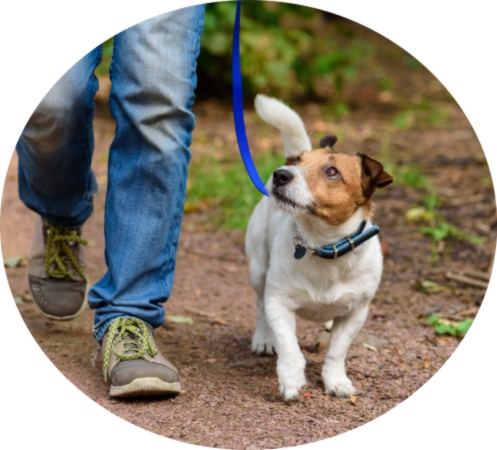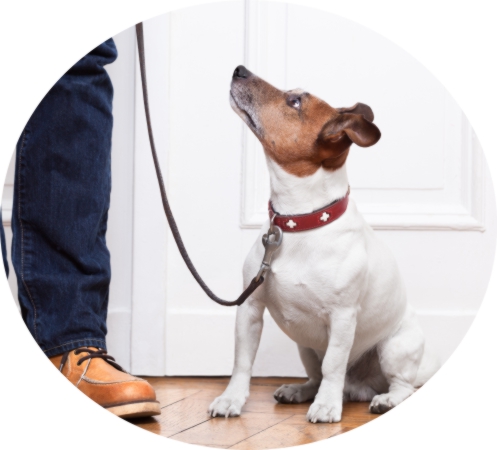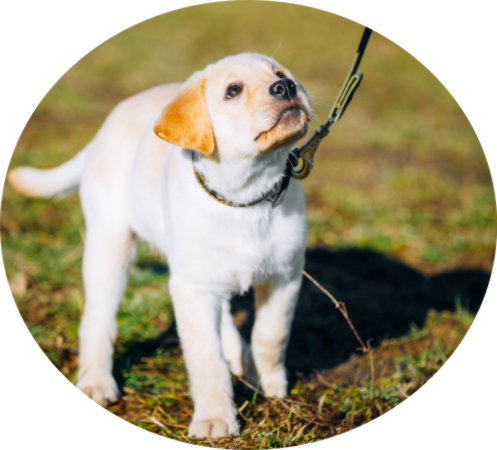
A question we often hear is, “How can I teach my dog to walk nicely on a leash?” You may have asked it yourself.
So, we will address this question and give you tips and training ideas to help you enjoy taking your dog on a well-mannered walk.
The Goal: To have your dog walk with you at your pace on a loose leash, glancing up to you occasionally for encouragement and reinforcement and for you, as the guardian, to enjoy walking with your dog.
So, what are your walks with your dog like? Pleasant or embarrassing?
Firstly, just a word about ‘SNIFF-ARIs’ (where you allow your dog to explore the environment through sniffing)
We believe that it is important to allow dogs room to sniff and explore the smells in the environment. It’s like reading posts on Facebook. They check out which dogs have recently posted on the nearest tree or lamppost. When they are right in the middle of their ‘sniff-ari’, sadly, we drag them away, saying to ourselves, ‘they must walk with us on a loose lead, at our pace, because that is the expected norm’. Is it?
Leash handling for exploring and sniffing is very different, when we allow our dogs room to move around and explore through sniffing. (If you want to find out more check our Grisha Stewart and her book BAT 2.0) But there are times that we need our dogs to walk with us in close proximity, like at the Foreshore. And this is where these lessons are very useful.
Remember, for a dog to walk with us at our slow pace is very unnatural for a dog. They often move slowly when they are anxious, old, fearful or obese, so please be patient with your dog as we go through these tips and techniques
The process starts with actually teaching your dog what to do in small steps without distractions. Many people assume that their dog knows what to do and when the dog fails, they are often labelled stubborn or disobedient.
Let’s assume instead that your dog knows nothing.
So the 3 steps will be:
Hold the lead in the hand away from the side your dog is at Keep your hand still. You may need to put your thumb in your pocket. This will help you not tug back at your dog.

Walk forward one step. Stop. Mark (with a clicker or a marker word) and reward them.
How? With the hand closest to the dog, give them a treat to the side of your knee
Walk forward one step. Stop. Mark (with a clicker or a marker word) and reward them as above
Then three steps. Stop. Mark. Reward
Remember this is Kindergarten so just one step at a time – High school will come later
Just a quick mention: When you walk forward leave on the leg next to the dog. It will give them a target to track. Well done you have passed Kindergarten
In your lounge room or kitchen:
Walk forward one step. TURN to The RIGHT. Stop. Mark (with a clicker or a marker word) and reward them. How?
With the hand closest to the dog, give them a treat to the side of your knee
Do lots of these Right Turns. Try Right about turns. When you complete the Right about turn. Stop. Mark. Reward
KEEP the RATE of reinforcement high – ·
Often a dog will be struggle with these baby steps in the kitchen. I’m not sure why we presume they can do it in the park with so many smells and distractions.
Remember: the park is high school. They are not there – yet!
What if my dog pulls forward?
Keep the hand in your pocket still, don’t extend your hand and don’t tug back.
When your dog reaches the end of the lead, they can’t go any further.
There isn’t enough momentum to pull you over on a short 4’ lead so stop and wait. You may need to bend your knees and lock in.
Eventually, when the dog looks around to you wondering why you have stopped or takes the pressure off, you can mark and reward.
If they don’t turn around quickly, you can use kissy sounds to help them understand what to do.
Use a short lead for these initial exercises in order to stop momentum building up.
Yeah! You’ve passed Grade 1, but your dog is not ready for high school!

In your lounge room or kitchen:
Tips:
Wow Grade 2 is hard. But see how far you’ve come!
Now lets go outside the front door. In preparation for Grade 3
Remember: Every we raise the level of difficulty with distractions, we have to go back to easy steps, so try this.
Outside your front door:
Yes!! You’ve made it through Grade 2 – But not ready for the Foreshore – Yet! That’s high school!
This article was written by qualified dog trainers in Western Australia, SueEllen Le Page from BFF Dog Training and Orlando Dos Santos from Results Dog Training. Sue and Orlando have been working hard to bring positive dog training information for your dog. For more articles and information visit and like their facebook page Positive Dog Matters